Dear David
By which criteria do you judge the upper watch on the picture (number 350)
to be a Pallweber I ?
For me it is just an "ordinary" Pallweber II .
Regards
Rolf
Pallweber nr. 554
- 101 replies
- last reply by sefru 16 May 2012
-
Insider
-
Connoisseur
I believe instead that the reconstruction of the batches prior to the documentation of the archives (moving up movement n. 6500) is possible and should be attempted. Today we can have much more data to those who had Meis and Toelke/King. Those studies were excellent, but now our knowledge is more and allowed us to see some inaccuracies in their work.
The important thing is to share the data.
For example, I consider that the movements nn. 1-300 were all Elgin I: the hypothesis must be verified, but it is a hypothesis that derives from the observation of the movements and will be denied if someone will find that a number of movement less than 300 is not a Elgin I. -
Graduate
Hi,
I was informed by David about this topic and thought to take part in it if you don't mind. I'm lucky to own some pieces of Pallweber pocket watches and there is a really scarce piece in my collection namely its bridges and plate are not gilt but rhodium plated. Since I'm new member I should find how to upload pictures and as soon as I have time I will do it so that you can see the movement. The other fact I would like to share is connected to the discuss about the serials of Pallwebers. My earliest piece has the 22XX serial number but one of my collector friends owns a piece which hasn't got any serial on the movement. I can also share picure of it.
Regards,
A
-
Graduate
Hi,
I'm also really curious why it is considered being Pallweber I.
The only Pallweber I. I have ever seen was signed by "Patent Pallweber" not at the usual place (between the bridges) but at the biggest visible surface on the plate between the escape wheel bridge and the balance bridge.
Regards
-
Connoisseur
Dear Arxi,
thank you for your intervention in this discussion.
I specify that n. 554 is signed "Patent Pallweber" just in the surface on the plate between the escape wheel bridge and the balance bridge.
But as far as I know this is also the location where is signed "Patent Pallweber" in Pallwebers II.Regards
-
Apprentice
Dear all,
I will share the pictures of the bottom side of Nr. 350 and 979 with you. Unfortunately here at home I have no access to the pictures.
The movements 350 and 979 haven’t been encased. They remained at IWC collection as movements only and were marked as Pallweber I and Pallweber II.
What makes the 350 different from 979: there is difference in the way IWC manufactured the small parts. e.g. the teeth of the wheels has been cut (350) and not milled just like with the 979.
Also the design of the bars/cocks of the hour, minute disk is different.Concerning the numbering system: the numbering system introduced in 1884 is consecutive. Yet, I never have seen in any batch a prototype. So presumably prototypes had not been included in the numbering system. But every movement whether it was pre- or a regular serial production has been numbered consecutively due to the (second) numbering system from 1884. I do not know and also believe that there has been double numbering.
So I absolutely agree with Giovanni: the more movements with numbers below 6501 we know, helps us to reconstruct the batches.As a matter of fact Johannes Rauschenbach was mot amused about the first type of mechanisms and prototypes that were made in Salzburg by Pallweber and son. Therefore IWC kept on improving the mechanism. This is why also Johannes Rauschenbach mentioned in 1885 a Pallweber " System 3 ". It hasn’t anything to do with quality but with describing the different systems of the mechanism. Interesting that in 1885 IWC used Arabic numeric and not Roman like the IWC calibre list of the 1920ies.
Best wishes and enjoy Sunday.
David Seyffer
Museum Curator -
Graduate
Dear all,
I would like to ask all of you whether there are other possibilities to upload pictures over the one is written above?
Regards,
Arxi -
Graduate
Hi,
thanks for your quick response.
Regards -
Graduate
Hi,
there is one more thing I would like to know connected to the early Pallweber movements namely the reason of the (two)three holes which exist often at the mentioned place (the same surface of the plate where the sign is) They seem like screw holes of some kind of bridge although there shouldn't be any additional bridge that place.
Regards
-
Connoisseur
Dear Arxi,
Your observation is very interesting and with what was said by David can help to distinguish Pallweber I and Pallweber II.
In Pallweber II there are always three holes in the surface on the plate between the escape wheel bridge and the balance bridge where there is the sign Patent Pallweber.
Some photos taken from internet can clarify:1) n. 13** from www.pocketwatch.ch/kiwc.htm#start
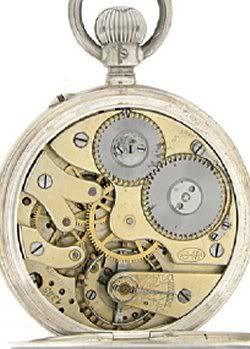
2) n. 1579 from www.faszination-uhrwerk.de/w/w19/a19/ankerwerke-19.html (the same in Meis, p. 51)
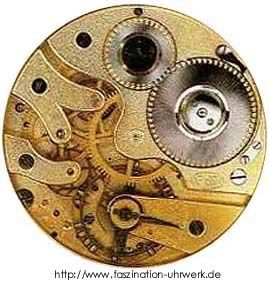
3) n. 3191 from this forum
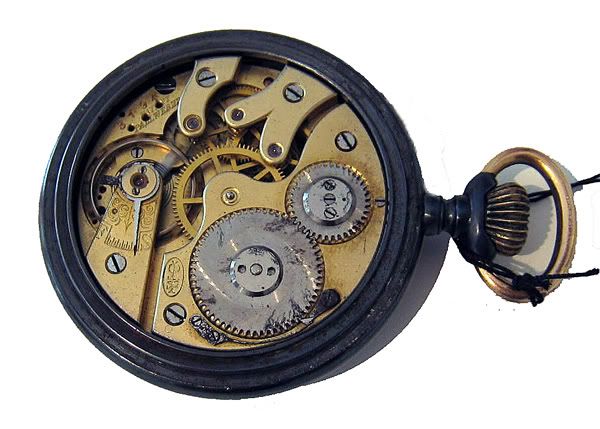
4) n. 3334 from internet

The holes there aren't in Pallweber I, as documented, for the movement n. 331, from Meis, p. 48, photos nn. 23 and 24:
1) n. unknown from www.faszination-uhrwerk.de/w/w19/a19/ankerwerke-19.html
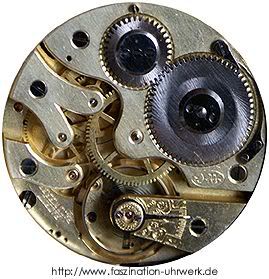
2) n. 554
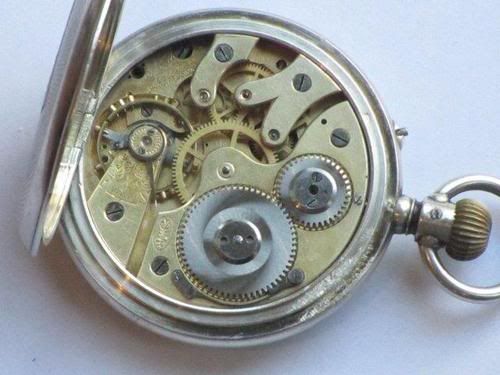
Also, in the bottom side of Pallweber I there is a hole for support of the thin plate-spring (that there is still in the n. 331) holding the "Kleinbodenrad".
This hole is instead absent in Pallweber II.Along with what was said by David and particularly the different design of the bars/cocks of the hour and minutes disk in the other side (front) of the movement these are some differences between Pallweber I and Pallweber II.
Regards
Giovanni
-
Master
Thank you David for your input. We await the photo's which will help clarify things.
Best regards
Mark -
Graduate
Hi Giovanni,
many thanks for the detailed response. As I mentioned I recently saw a Pallweber pocket watch with the same type dial as yours has and mine one has (Pallweber II) but the movement hasn't got any serial number on it. Mine one bears it right next to the patent sign. What about yours one, I can't see clearly its position in the pictures.
Regards,
Áron -
Graduate
Dear Giovanni,
the first picture of the second row (or the second picture from the end /the "unkown"/) seems to be a Pallweber I. doesn't it? The one I have seen is allaged to be also Pallweber I and has the same holes on the plate without any serial.
Waiting for your respons,best regards,
Á
-
Master
This is interesting.
I am quite shure the watch is not rhodium coated plated it has
- a nickel plate (not brass rhodium coared
- and Breguet balance spring
- the normal "Spiralklötchen" (balance spring stud) used in IWC watches.
- and probably no serial number on the movementI saw once such a movement in a poor condition.
(P.S. To place pictures you just need a Web-server the place the pictures.
If you have none, you can send me the pictures of the pallweber, an I can sher them for you.) -
Mastercosti92 has written:Ralph Ehrismann has written:
I think the theories for the movement number batches are realy just theories.
For prototypes I think they mady any number of movements (50, 100, 150, 300...)I believe instead that the reconstruction of the batches prior to the documentation of the archives (moving up movement n. 6500) is possible and should be attempted. Today we can have much more data to those who had Meis and Toelke/King. Those studies were excellent, but now our knowledge is more and allowed us to see some inaccuracies in their work.
The important thing is to share the data.
For example, I consider that the movements nn. 1-300 were all Elgin I: the hypothesis must be verified, but it is a hypothesis that derives from the observation of the movements and will be denied if someone will find that a number of movement less than 300 is not a Elgin I.I think the numbering of the Pallwebers and the Elgins could be overlapping (same numbers) or completly mixed (no patches, just numbered 10 by 10 or even smaller batches...
It seems there are Elgins in the 4- and 5- hundreds, as well as there was onve a pallweber spotted in the 1-hundreds.
(It seems that there is in my collection an Elgin I with the number 314)regards
Ralph
-
ConnoisseurRalph Ehrismann has written:
I think the numbering of the Pallwebers and the Elgins could be overlapping (same numbers) or completly mixed (no patches, just numbered 10 by 10 or even smaller batches...
It seemsthere are Elgins in the 4- and 5- hundreds, as well as there was onve a pallweber spotted in the 1-hundreds.
(It seemsthat there is in my collection an Elgin I with the number 314)regards
Ralph
Thank you Ralph,
Your observation is very important.
But what do you mean by the words "It seems"?
It would be very interesting to see the pictures! -
Connoisseurarxi has written:
Hi Giovanni,
many thanks for the detailed response. As I mentioned I recently saw a Pallweber pocket watch with the same type dial as yours has and mine one has (Pallweber II) but the movement hasn't got any serial number on it. Mine one bears it right next to the patent sign. What about yours one, I can't see clearly its position in the pictures.
Regards,
ÁronDear Áron,
It's interesting to note that the Pallwebers I and II have the indication "International Watch Co" in the upper part of the dial, while the Pallwebers III in the lower. I add an empirical remark: in Pallweer II I have always found the indication "International Watch Co", in n. 554 indeed is written "International Watch Company".
It would be very interesting to see pictures of yours (dial and movement)!
In 554 the number of the movement is above the patent sign. -
Connoisseurarxi has written:
Dear Giovanni,
the first picture of the second row (or the second picture from the end /the "unkown"/) seems to be a Pallweber I. doesn't it? The one I have seen is allaged to be also Pallweber I and has the same holes on the plate without any serial.
Waiting for your respons,best regards,
Á
Yes it is a Pallweber I, but just I don't know the number. However it seems to me that the 554 has the same holes on the plate.
It would be very interesting to see pictures of the movement without serial number!
Regards
Giovanni